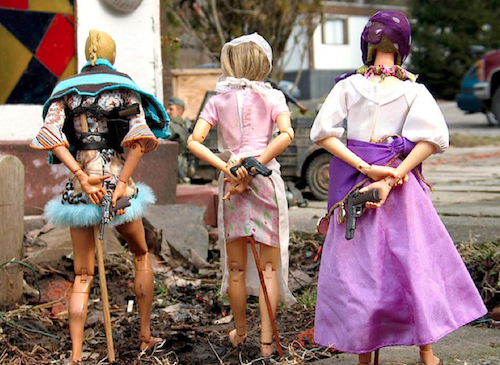Several years ago, I opened an art magazine and read a feature about an upstate New York man with an astounding story. His name is Mark Hogancamp, and in April of 2000, he was beaten senseless outside a bar in downtown Kingston. Thirty-eight years old at the time, he came out of a nine-day coma with a surgically rebuilt face and a head kicked clean of all memory. After his state-sponsored health care and rehab ran out, he returned home to deal with the cognitive damage and severe post-traumatic stress that resulted from being attacked by five strangers who hated his guts. Why did they hate his guts, you ask? Because in the drunken camaraderie he mistakenly thought they were sharing inside the bar, Hogancamp confided that he sometimes likes to dress in women’s clothing. They waited for him outside and nearly killed him.
The reason he was written up in an art magazine was because the therapy he devised for himself to deal with the trauma he suffered was a town called Marwencol. Named for Mark and two friends, Wendy and Colleen, Marwencol is a 1/6 scale Belgian World War II town Hogancamp constructed of plywood, sweat, and determination in his backyard, then populated with action figures and Barbie dolls to represent him, his friends, the townspeople, the Nazis, and anyone else his imagination could conjure up. He devises elaborate serial stories for his alter ego, Hogie, to act out. First, he has Hogie crash land in Marwencol and rally the townspeople to fight the SS and regain control of their village. Once the Nazis are driven out, Hogie makes it a place where everyone can coexist peacefully. No one passes judgment; people don’t gang up on each other. The town’s only rule is to be friends. But it’s WWII and the SS come back, so Hogie and company have to beat the bloody crap out of them. It’s all Mark Hogancamp’s way of dealing with his pain through play. Instead of acting out his anger and frustration on real people, he lets Hogie do it for him. After all, it’s wartime. Aggression is expected.
But war isn’t the only thing on Mark’s mind. Friendship, love, heroism, betrayal, joy, insecurity — they’re all part of life in Marwencol. Mark’s uncanny artistic talent survived the attack and aids in rebuilding his fine motor skills. He repaints the factory faces on his figures so they are instantly recognizable as the people they represent, right down to the scars on Hogie’s face from Mark’s surgeries. The town is crowded with people, buildings, battles, and celebrations. In meticulously staged, brilliantly captured photographs, Mark fills Marwencol with the memories he wishes he had.
After the magazine spread in 2005, Mark was approached by an art gallery in Manhattan about having a one-man show. With great trepidation he agreed, and White Columns had an exhibition of his breathtaking photography in 2006. Around the same time, Mark was asked by a documentarian to make a movie. Jeff Malmberg’s Marwencolwas released last year and won several indie film awards. It is now available on DVD and it’s a knockout. This is all overwhelming for Hogancamp, who says in the movie, “My mind can’t decide what world to go in. The realistic world? There are dangers out there. I feel safe when I get in my town and it just takes everything away. I prefer to live in my world. I want to live here, in Marwencol.” It may be the real world’s loss, but at least we can visit.
Click the link below to read more, watch a trailer, or buy the DVD.
Scenes from Marwencol, where fantasy meets reality and the good guys always win






